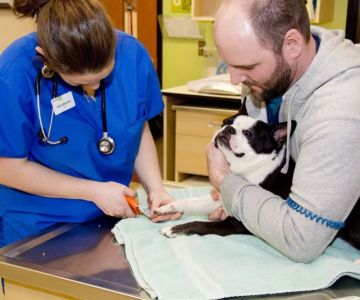How Long Is School to Become a Veterinarian? A Detailed Guide
- Understanding the Education Pathway to Becoming a Veterinarian
- Steps to Becoming a Veterinarian
- Factors Affecting the Duration of Veterinary School
- Real-Life Stories of Aspiring Veterinarians
- Career Outlook for Veterinarians
Becoming a veterinarian is a fulfilling and rewarding career, but it requires years of education and training. If you’ve been wondering how long is school to become a veterinarian, this article will guide you through the education and training timeline, along with important steps and factors to consider along the way.
Understanding the Education Pathway to Becoming a Veterinarian
To become a veterinarian, individuals typically need to complete an extensive education that includes undergraduate studies, veterinary school, and potentially additional specialization. On average, it takes around 8 years to complete the full education required to become a licensed veterinarian. Here's how the journey usually unfolds:
1. Undergraduate Education (4 Years)
Most veterinary schools require applicants to have a bachelor’s degree before they can be admitted. While you don't need a specific major, most aspiring veterinarians pursue degrees in biology, animal science, or other related fields. These 4 years of undergraduate study provide a solid foundation in subjects like biology, chemistry, and physics, which are essential for success in veterinary school.
2. Veterinary School (4 Years)
Once you have completed your undergraduate degree, the next step is to attend veterinary school. Veterinary school is a rigorous, 4-year program that provides both theoretical knowledge and practical experience in veterinary medicine. The first two years typically focus on classroom instruction in subjects such as anatomy, pathology, and pharmacology. The last two years focus on clinical practice, where students gain hands-on experience through rotations at veterinary hospitals or clinics.
3. Internship or Residency (Optional, 1-3 Years)
While not required, some veterinarians choose to further specialize in areas such as surgery, dermatology, or internal medicine. This can involve completing an internship (1 year) or a residency (2-3 years) after graduation. This additional training allows veterinarians to gain in-depth knowledge and experience in their chosen field, which can be beneficial for those interested in specialized practices.
Steps to Becoming a Veterinarian
Let’s break down the essential steps in the process of becoming a veterinarian:
1. Complete an Undergraduate Degree
Before applying to veterinary school, you must first complete a 4-year undergraduate program. The focus should be on courses related to science and animals. It’s also important to gain experience working with animals through internships or volunteer work, as most veterinary schools require applicants to have hands-on experience in animal care.
2. Apply to Veterinary School
After completing your undergraduate degree, you will need to apply to a veterinary school. The competition can be fierce, so it’s important to maintain strong grades and have substantial experience working with animals. Veterinary school typically requires a passing score on the Graduate Record Examination (GRE) as well as a strong application, including personal statements and letters of recommendation.
3. Graduate from Veterinary School
Once accepted into veterinary school, you will need to complete the 4-year program, which involves both academic coursework and clinical training. Graduates of veterinary schools are awarded a Doctor of Veterinary Medicine (DVM) or Veterinariae Medicinae Doctoris (VMD) degree, depending on the school.
4. Obtain Licensing
After graduation, veterinarians must pass the North American Veterinary Licensing Exam (NAVLE) to practice professionally. Depending on the state or country, there may be additional licensing requirements, including state exams or continuing education courses.
Factors Affecting the Duration of Veterinary School
While the general timeline for becoming a veterinarian is around 8 years, there are several factors that can affect how long it takes:
1. Geographic Location
The duration and requirements for veterinary education can vary by country or even by state. For example, some countries may offer accelerated veterinary programs, while others may have additional requirements for licensure or clinical practice.
2. Specialization
If you choose to specialize in a specific field of veterinary medicine, such as surgery, dentistry, or dermatology, additional years of training may be required. Specialization involves completing an internship and residency, which can extend your training by 2-3 years.
3. Personal Circumstances
Life events, financial concerns, or personal choices can also affect the timeline. Some people may choose to take a gap year between their undergraduate degree and veterinary school, while others may attend school part-time or take a leave of absence during their training.
Real-Life Stories of Aspiring Veterinarians
Let’s take a look at the stories of a couple of individuals who pursued their dream of becoming a veterinarian:
1. Sarah's Journey
Sarah always knew she wanted to work with animals, but she didn't realize how long it would take to become a veterinarian. After completing her undergraduate studies in biology, she spent four years in veterinary school. After graduation, Sarah pursued a year-long internship in equine medicine to specialize in horse care. Today, Sarah runs a successful practice helping horses and large animals, having spent a total of 9 years in education and training.
2. David's Career Path
David, on the other hand, knew he wanted to become a veterinarian but was particularly interested in small animals. After his 4-year undergraduate degree, he completed his veterinary school program and passed the licensing exam. While David didn’t pursue a specialty, his passion for animal care led him to open his own practice after 8 years of education and training.
Career Outlook for Veterinarians
The veterinary profession offers a variety of career paths, including working with small animals, large animals, or exotic pets. The job outlook for veterinarians is generally positive, with a growing demand for veterinary services in various fields, including animal hospitals, research institutions, and wildlife conservation.
In conclusion, how long is school to become a veterinarian? On average, you can expect around 8 years of education, including undergraduate studies and veterinary school, with additional time for specialization if desired. For those passionate about animal health, the journey to becoming a veterinarian is long but incredibly rewarding. If you’re ready to start your journey, explore educational resources and veterinary schools today to take the first step toward your veterinary career.











